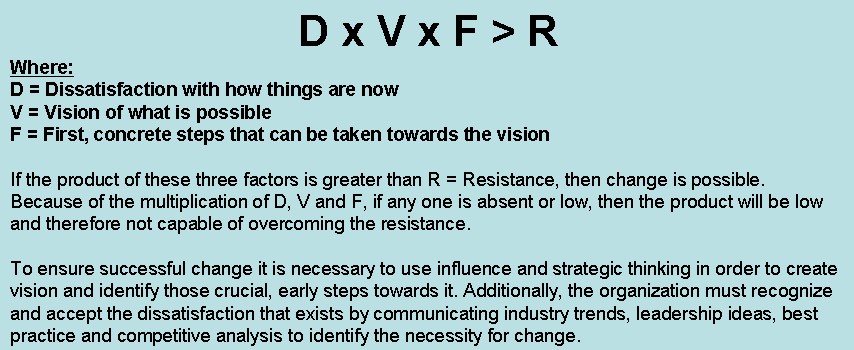Change Management
Overview
Organizations are primarily social systems. Without people there can be no organization. The problem is that people are extremely resistant to change, even if it is perceived as easy. In order for meaningful change to occur the combination of organizational dissatisfaction with the current state, a vision for an improved future and the possibility of immediate, tactical action must be stronger than the resistance within the organisation.
Our consultants will work with your people to achieve “buy-in” at all levels.
Scope And Deliverables
 Attitudes towards change result from a complex interplay of emotions and cognitive processes. Because of this complexity everyone reacts to change differently. On the positive side, change is seen as akin to opportunity, rejuvenation, progress, innovation, and growth. However, just as legitimately, change can also be seen as akin to instability, upheaval, unpredictability, threat, and disorientation. Whether employees perceive change with fear, anxiety and demoralization, or with excitement and confidence, or somewhere in between, depends partially on the individual’s psychological makeup, partially on management’s actions, and partially on the specific nature of the change.
Attitudes towards change result from a complex interplay of emotions and cognitive processes. Because of this complexity everyone reacts to change differently. On the positive side, change is seen as akin to opportunity, rejuvenation, progress, innovation, and growth. However, just as legitimately, change can also be seen as akin to instability, upheaval, unpredictability, threat, and disorientation. Whether employees perceive change with fear, anxiety and demoralization, or with excitement and confidence, or somewhere in between, depends partially on the individual’s psychological makeup, partially on management’s actions, and partially on the specific nature of the change.
An individual’s attitude toward a change tends to evolve as they become more familiar with it. The stages a person goes through can consist of apprehension, denial, anger, resentment, depression, cognitive dissonance, compliance, acceptance, and internalization. It is the leadership team’s job to create an environment in which people can go through these stages as quickly as possible, and even skip some of them.
Effective change management programs are frequently sequential, with early measures directed at overcoming the initial apprehension, denial, anger, and resentment, but gradually evolving into a program that supports compliance, acceptance, and internalization.
There are four main strategies for implementing change:
- Rational – People will follow their self-interest, as long as it is clear to them. Change is based on communication and incentives.
- Cultural – People will follow the social or cultural norms. Change is based on defining and committing to new norms and group values.
- Power – People will do what they’re told. Change is based on the exercise of authority.
- Adaptive – People will adapt to new circumstances. Change is based on creating new systems.
Every organization is different, requiring a specific combination of all four of these change management strategies. Complicating this picture is that it isn’t just where your organization is today . . . but where it wants to be in the future.
Change agents need to have skills in several areas in order to be effective:
- Business – An understanding of how business and the flow of money works is crucial. An outside viewpoint usually provides perspective that is often missing internally.
- System – The interaction of the processes, the technologies and the organizational culture within your business defines the overall system.
- People – Change agents are usually called to help mitigate conflict between different points of view. This requires excellent communication and interpersonal skills.
- Analytical – Change agents must be able to take apart and reassemble operations and systems in novel ways, and then determine the financial and political impacts of what their recommendations. Also, they must be able to start with some financial measure or indicator or goal, and reconfigure operations and systems that would provide the desired outcomes.
- Political – It is absolutely critical that your consultant understands how to interact with your organization’s internal politics, while being careful not to join in.
What We Will Do
- Facilitate leadership team meetings to clearly articulate a vision of the future state that includes the desired outcomes for the change.
- Understand your organization’s current culture, processes and practices. This will clarify your organization’s dissatisfaction with the current state.
- Define a change strategy (or combination of strategies) that is/are consistent with your organizational system.
- Propose a methodology for achieving the change, that shows immediate and highly tactical actions.
- Provide a clear roadmap and timeline for implementing the methodology.
- Facilitate the implementation of the agreed-upon change strategy.
- Develop an agreed-upon approach for measuring and monitoring progress.
- Create an appropriate progress communication vehicle.
- Provide guidance on an organizationally suitable reward and recognition approach.
What We Need You To Do
- Commit to the change.
- Ensure the active participation of the leadership team in the change program.
- Provide us with access to the required internal personnel.
- Authorize those personnel to provide us with the required information in a timely fashion.
- Assign resources as needed.
WHAT PEOPLE ARE SAYING
SatiStar's Experience Makes The Difference!
